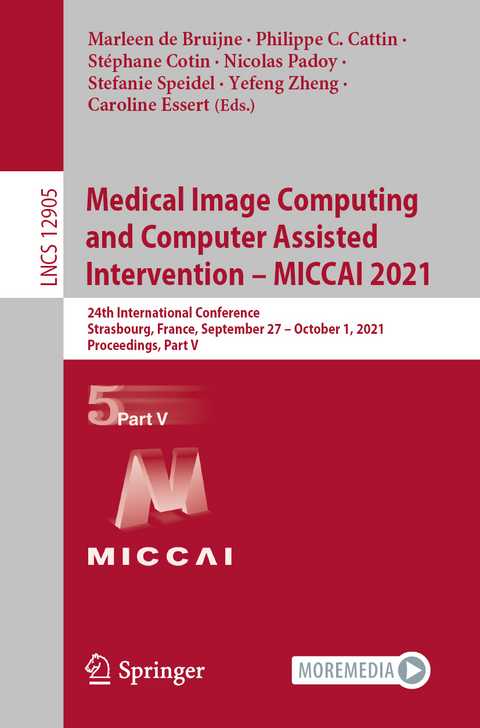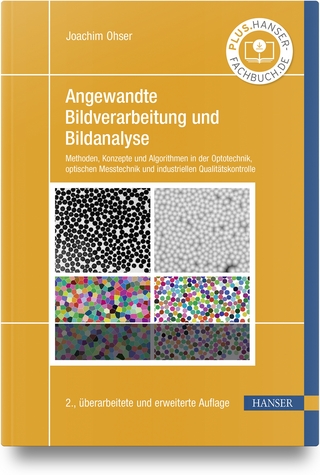
Medical Image Computing and Computer Assisted Intervention – MICCAI 2021
Springer International Publishing (Verlag)
978-3-030-87239-7 (ISBN)
The 531 revised full papers presented were carefully reviewed and selected from 1630 submissions in a double-blind review process. The papers are organized in the following topical sections:
Part I: image segmentation
Part II: machine learning - self-supervised learning; machine learning - semi-supervised learning; and machine learning - weakly supervised learning
Part III: machine learning - advances in machine learning theory; machine learning - attention models; machine learning - domain adaptation; machine learning - federated learning; machine learning - interpretability / explainability; and machine learning - uncertainty
Part IV: image registration; image-guided interventions and surgery; surgical data science; surgical planning and simulation; surgical skill and work flow analysis; and surgical visualization and mixed, augmented and virtual reality
Part V: computer aided diagnosis; integration of imaging with non-imaging biomarkers; and outcome/disease prediction
Part VI: image reconstruction; clinical applications - cardiac; and clinical applications - vascular
Part VII: clinical applications - abdomen; clinical applications - breast; clinical applications - dermatology; clinical applications - fetal imaging; clinical applications - lung; clinical applications - neuroimaging - brain development; clinical applications - neuroimaging - DWI and tractography; clinical applications - neuroimaging - functional brain networks; clinical applications - neuroimaging - others; and clinical applications - oncology
Part VIII: clinical applications - ophthalmology; computational (integrative) pathology; modalities - microscopy; modalities - histopathology; and modalities - ultrasound
*The conference was held virtually.
Computer Aided Diagnosis.- DeepStationing: Thoracic Lymph Node Station Parsing in CT Scans using Anatomical Context Encoding and Key Organ Auto-Search.- Hepatocellular Carcinoma Segmentation from Digital Subtraction Angiography Videos using Learnable Temporal Difference.- CA-Net: Leveraging Contextual Features for Lung Cancer Prediction.- Semi-Supervised Learning for Bone Mineral Density Estimation in Hip X-ray Images.- DAE-GCN: Identifying Disease-Related Features for Disease Prediction.- Enhanced Breast Lesion Classification via Knowledge Guided Cross-Modal and Semantic Data Augmentation.- Multiple Meta-model Quantifying for Medical Visual Question Answering.- mfTrans-Net: Quantitative Measurement of Hepatocellular Carcinoma via Multi-Function Transformer Regression Network.- You Only Learn Once: Universal Anatomical Landmark Detection.- A Coherent Cooperative Learning Framework Based on Transfer Learning for Unsupervised Cross-domain Classification.- Towards a non-invasive diagnosis of portal hypertension based on an Eulerian CFD model with diffuse boundary conditions.- A Segmentation-Assisted Model for Universal Lesion Detection with Partial Labels.- Constrained Contrastive Distribution Learning for Unsupervised Anomaly Detection and Localisation in Medical Images.- Conditional Training with Bounding Map for Universal Lesion Detection.- Focusing on Clinically Interpretable Features: Selective Attention Regularization for Liver Biopsy Image Classification.- Categorical Relation-Preserving Contrastive Knowledge Distillation for Medical Image Classification.- Tensor-based Multi-index Representation Learning for Major Depression Disorder Detection with Resting-state fMRI.- Region Ensemble Network for MCI Conversion Prediction With a Relation Regularized Loss.- Airway Anomaly Detection by Graph Neural Network.- Energy-Based Supervised Hashing for Multimorbidity Image Retrieval.- Stochastic 4D Flow Vector-Field Signatures: A new approach for comprehensive 4D Flow MRI quantification.- Source-Free Domain Adaptive Fundus Image Segmentation with Denoised Pseudo-Labeling.- ASC-Net: Adversarial-based Selective Network for Unsupervised Anomaly Segmentation.- Cost-Sensitive Meta-Learning for Progress Prediction of Subjective Cognitive Decline with Brain Structural MRI.- Effective Pancreatic Cancer Screening on Non-contrast CT Scans via Anatomy-Aware Transformers.- Learning from Subjective Ratings Using Auto-Decoded Deep Latent Embeddings.- VertNet: Accurate Vertebra Localization and Identification Network from CT Images.- VinDr-SpineXR: A deep learning framework for spinal lesions detection and classification from radiographs.- Multi-frame Collaboration for Effective Endoscopic Video Polyp Detection via Spatial-Temporal Feature Transformation.- MBFF-Net: Multi-Branch Feature Fusion Network for Carotid Plaque Segmentation in Ultrasound.- Balanced-MixUp for highly imbalanced medical image classification.- Transfer Learning of Deep Spatiotemporal Networks to Model Arbitrarily Long Videos of Seizures.- Retina-Match: Ipsilateral Mammography Lesion Matching in a Single Shot Detection Pipeline.- Towards Robust Dual-view Transformation via Densifying Sparse Supervision for Mammography Lesion Matching.- DeepOPG: Improving Orthopantomogram Finding Summarization with Weak Supervision.- Joint Spinal Centerline Extraction and Curvature Estimation with Row-wise Classification and Curve Graph Network.- LDPolypVideo Benchmark: A Large-scale Colonoscopy Video Dataset of Diverse Polyps.- Continual Learning with Bayesian Model based on a Fixed Pre-trained Feature Extractor.- Alleviating Data Imbalance Issue with Perturbed Input during Inference.- A Deep Reinforced Tree-traversal Agent for Coronary Artery Centerline Extraction.- Sequential Gaussian Process Regression for Simultaneous Pathology Detection and Shape Reconstruction.- Predicting Symptoms from Multiphasic MRI via Multi-Instance Attention Learning for Hepatocellular Carcinoma Grading.- Triplet-Branch Network with Prior-Knowledge Embedding for Fatigue Fracture Grading.- DeepMitral: Fully Automatic 3D Echocardiography Segmentation for Patient Specific Mitral Valve Modelling.- Data Augmentation in Logit Space for Medical Image Classification with Limited Training Data.- Collaborative Image Synthesis and Disease Diagnosis for Classification of Neurodegenerative Disorders with Incomplete Multi-modal Neuroimages.- Seg4Reg+: A Local and Global ConsistencyLearning between Spine Segmentation and CobbAngle Regression.- Meta-Modulation Network for Domain Generalization in Multi-site fMRI Classification.- 3D Brain Midline Delineation for Hematoma Patients.- Unsupervised Representation Learning Meets Pseudo-Label Supervised Self-Distillation: A New Approach to Rare Disease Classification.- nnDetection: A Self-configuring Method for Medical Object Detection.- Automating Embryo Development Stage Detection in Time-Lapse Imaging with Synergic Loss and Temporal Learning.- Deep Neural Dynamic Bayesian Networks applied to EEG sleep spindles modeling.- Few Trust Data Guided Annotation Refinement for Upper Gastrointestinal Anatomy Recognition.- Asymmetric 3D Context Fusion for Universal Lesion Detection.- Detecting Outliers with Poisson Image Interpolation.- MG-NET: Leveraging Pseudo-Imaging for Multi-Modal Metagenome Analysis.- Multimodal Multitask Deep Learning for X-Ray Image Retrieval.- Linear Prediction Residual for Efficient Diagnosis of Parkinson's Disease from Gait.- Primary Tumor and Inter-Organ Augmentations for Supervised Lymph Node Colon Adenocarcinoma Metastasis Detection.- Radiomics-informed Deep Curriculum Learning for Breast Cancer Diagnosis.- Integration of Imaging with Non-Imaging Biomarkers.- Lung Cancer Risk Estimation with Incomplete Data: A Joint Missing Imputation Perspective.- Co-Graph Attention Reasoning based Imaging and Clinical Features Integration for Lymph Node Metastasis Prediction.- Deep Orthogonal Fusion: Multimodal Prognostic Biomarker Discovery Integrating Radiology, Pathology, Genomic, and Clinical Data.- A Novel Bayesian Semi-parametric Model for Learning Heritable Imaging Traits.- Combining 3D Image and Tabular Data via the Dynamic Affine Feature Map Transform.- Image-derived phenotype extraction for genetic discovery via unsupervised deep learning in CMR images.- GKD: Semi-supervised Graph Knowledge Distillation for Graph-Independent Inference.- Outcome/Disease Prediction.- Predicting Esophageal Fistula Risks Using a Multimodal Self-Attention Network.- Hybrid Aggregation Network for Survival Analysis from Whole Slide Histopathological Images.- Intracerebral Haemorrhage Growth Prediction Based on Displacement Vector Field and Clinical Metadata.- AMINN: Autoencoder-based Multiple Instance Neural Network Improves Outcome Prediction of Multifocal Liver Metastases.- Survival Prediction Based on Histopathology Imaging and Clinical Data: A Novel, Whole Slide CNN Approach.- Beyond Non-Maximum Suppression - Detecting Lesions in Digital Breast Tomosynthesis Volumes.- A Structural Causal Model MR Images of Multiple Sclerosis.- EMA: Auditing Data Removal from Trained Models.- AnaXNet: Anatomy Aware Multi-label Finding Classification in Chest X-ray.- Projection-wise Disentangling for Fair and Interpretable Representation Learning: Application to 3D Facial Shape Analysis.- Attention-based Multi-scale Gated Recurrent Encoder with Novel Correlation Loss for COVID-19 Progression Prediction.
| Erscheinungsdatum | 27.09.2021 |
|---|---|
| Reihe/Serie | Image Processing, Computer Vision, Pattern Recognition, and Graphics | Lecture Notes in Computer Science |
| Zusatzinfo | XXXVIII, 839 p. 25 illus. |
| Verlagsort | Cham |
| Sprache | englisch |
| Maße | 155 x 235 mm |
| Gewicht | 1324 g |
| Themenwelt | Informatik ► Grafik / Design ► Digitale Bildverarbeitung |
| Informatik ► Theorie / Studium ► Künstliche Intelligenz / Robotik | |
| Schlagworte | Applications • Artificial Intelligence • Bioinformatics • Computer Aided Diagnosis • computer assisted interventions • Computer Science • computer vision • conference proceedings • Image Processing • image reconstruction • Image Segmentation • Imaging Systems • Informatics • machine learning • Medical Image Analysis • Medical Images • Neural networks • pattern recognition • Research • Signal Processing |
| ISBN-10 | 3-030-87239-4 / 3030872394 |
| ISBN-13 | 978-3-030-87239-7 / 9783030872397 |
| Zustand | Neuware |
| Haben Sie eine Frage zum Produkt? |
aus dem Bereich


